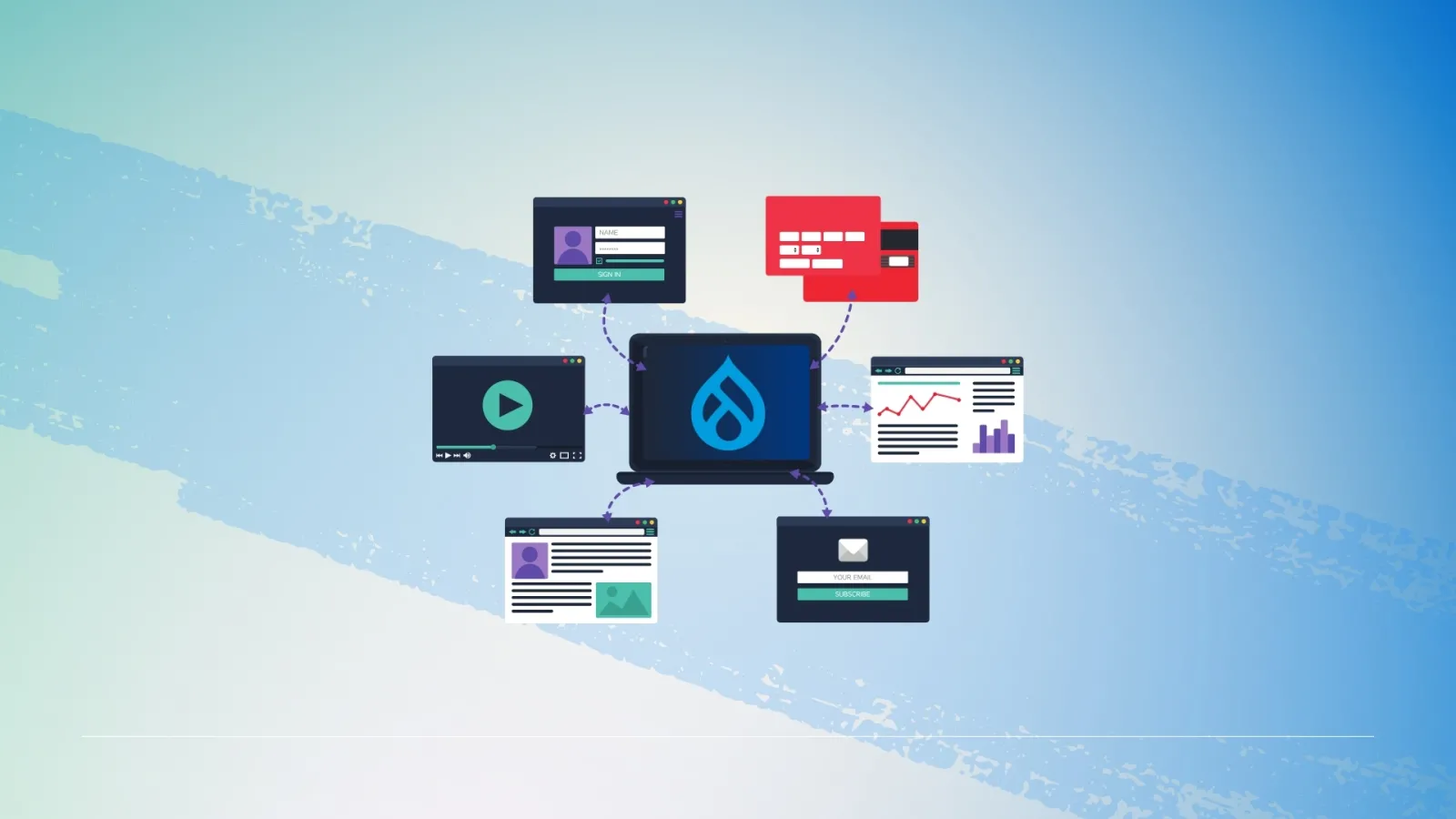Many organizations still running Drupal 7 find themselves at a critical decision point. With official community support having ended, the financial implications of delaying migration have become increasingly significant. This article examines the true costs of remaining on Drupal 7 and provides a framework for calculating your organization's specific migration ROI.
The Hidden Financial Impact of Outdated Drupal Infrastructure
When assessing Drupal 7 migration costs, most organizations focus solely on the immediate project expenses. However, this narrow view misses the substantial ongoing costs of maintaining legacy systems. For multi-brand enterprises and organizations managing multiple websites, these expenses multiply across each property, creating a compounding financial burden.
The true cost equation extends far beyond implementation expenses. Each month your organization delays migration from Drupal 7, you accumulate technical debt and face increasing operational expenses that could otherwise be invested in growth initiatives.
Quantifying Drupal 7 Technical Debt
Technical debt represents the future cost implications of choosing expedient solutions today rather than implementing proper fixes. For Drupal 7 sites, this debt accumulates through several channels:
Security Vulnerability Management
With community support ended, security updates for Drupal 7 now require specialized attention. Enterprise organizations must either purchase vendor-supported security programs or allocate internal resources to monitor and patch vulnerabilities manually. This security management typically costs between $20,000-$50,000 annually for mid-sized organizations, depending on site complexity and number of instances.
One financial services client discovered they were spending over $38,000 annually just maintaining security compliance for their legacy Drupal 7 infrastructure—resources that could have been directed toward innovation rather than maintenance.
Developer Productivity Losses
As fewer developers maintain expertise in Drupal 7, finding qualified talent becomes increasingly challenging and expensive. Current market rates show a premium of 20-30% for developers with legacy system experience, particularly those familiar with outdated Drupal versions.
Beyond higher rates, productivity metrics reveal an even more concerning trend: developers spend approximately 30% more time implementing changes on Drupal 7 versus Drupal 11 sites. For an organization with five developers working on Drupal projects, this inefficiency translates to essentially losing 1.5 full-time resources annually.
Integration Complications
Modern marketing and business tools increasingly stop supporting integration with legacy systems. When vendors announce the end of support for Drupal 7 connections, organizations face difficult choices: custom-develop new integration methods, abandon useful tools, or hastily migrate under pressure.
Calculating Your Drupal 7 Migration ROI
Understanding the return on investment for Drupal migration requires a comprehensive assessment of both current costs and future benefits. The following framework helps quantify these factors:
Current Monthly Carrying Costs
Start by documenting all expenses directly related to maintaining your Drupal 7 infrastructure:
- Security Management Expenses: Include vendor security support contracts, security audit costs, and internal resource time dedicated to vulnerability monitoring and patching.
- Developer Inefficiency Costs: Calculate the productivity differential between your current system and modern Drupal. If developers spend 30% more time on maintenance and feature implementation, multiply this percentage by your monthly development payroll.
- Infrastructure Expenses: Older systems typically require more server resources and manual intervention. Compare your current hosting and infrastructure management costs against industry benchmarks for modern implementations.
- Opportunity Cost Calculation: Consider strategic initiatives delayed due to technical limitations. While challenging to quantify precisely, many organizations assign a monthly value to delayed market opportunities.
Migration Investment Analysis
Accurately assessing Drupal 7 migration costs requires understanding several investment categories:
- Discovery and Planning: Thorough assessment of current architecture, content, custom functionality, and integrations typically represents 10-15% of total project costs.
- Implementation Expenses: The core migration work including platform setup, content migration, theme development, and custom functionality rebuilding usually accounts for 60-70% of the budget.
- Testing and Quality Assurance: Comprehensive testing across devices, browsers, and user scenarios typically requires 15-20% of the total budget.
- Training and Knowledge Transfer: Ensuring your team can effectively manage the new platform represents approximately 5-10% of project costs.
Long-term Financial Benefits
Migration delivers several quantifiable benefits that should factor into your ROI calculations:
- Maintenance Cost Reduction: Organizations typically see a 40-60% reduction in ongoing maintenance costs after migrating to Drupal 11, primarily through reduced security management expenses and improved development efficiency.
- Infrastructure Optimization: Modern Drupal implementations leverage improved caching and database optimizations, typically delivering 30-40% reductions in hosting requirements and associated costs.
- Marketing Agility Value: The ability to launch campaigns and features faster has tangible financial benefits. Organizations report 25-35% faster time-to-market for new initiatives after migration.
Real-World Cost Comparison Case Study
A multi-brand retail organization operating seven websites on Drupal 7 conducted a detailed cost analysis before their migration decision. Their findings proved illuminating:
Annual Drupal 7 Maintenance Costs:
Security management: $42,000
Developer inefficiency (additional time): $180,000
Custom integration work: $95,000
Extended support contracts: $38,000
Total annual carrying cost: $355,000
Migration Investment:
Total one-time migration cost: $420,000
Post-Migration Annual Savings:
Reduced security expenses: $36,000
Developer efficiency gains: $145,000
Avoided custom integration needs: $80,000
Eliminated support contracts: $38,000
Total annual savings: $299,000
With an annual savings of $299,000 against a one-time investment of $420,000, the project achieved ROI in approximately 17 months. More importantly, the organization redirected these savings toward customer experience improvements rather than maintenance.
The Escalating Cost of Waiting
Organizations often underestimate how Drupal 7 migration costs increase over time. Several factors contribute to this escalation:
Complexity Accumulation
As your Drupal 7 site ages, customizations, content, and technical workarounds accumulate. Each month adds complexity to the eventual migration, increasing the ultimate project cost by approximately 1-2% per quarter according to migration specialists.
Forced Migration Scenarios
Organizations that delay until an emergency scenario (such as a security breach or critical system failure) typically spend 40-60% more on migration projects due to compressed timelines, limited planning, and reduced leverage with vendors.
Opportunity Cost Acceleration
The longer an organization maintains legacy systems, the greater the competitive disadvantage becomes. Market studies indicate that companies using modern, flexible digital platforms capture market share 2-3 times faster than those constrained by legacy systems.
Calculating Your Organization's Migration Timeline
While every organization has unique considerations, financial modeling suggests ideal migration timing based on current carrying costs:
If your annual Drupal 7 maintenance costs exceed 60% of estimated migration expenses, immediate migration typically delivers the strongest financial return.
When maintenance costs range between 40-60% of migration expenses, a 6-12 month migration timeline usually optimizes both resource allocation and risk management.
Organizations with maintenance costs below 40% of migration expenses may have slightly more flexibility, though should still establish a defined timeline within 18 months to avoid accelerating costs.
Beyond Financial Considerations: Business Continuity Risks
While quantifiable expenses provide compelling reasons for Drupal 7 migration, organizations must also consider business continuity risks that, while harder to quantify, could prove far more costly:
Security Breach Exposure
As vulnerabilities in Drupal 7 continue to emerge with fewer resources dedicated to patching them, the risk of a significant security breach increases substantially. For enterprises, the average cost of a data breach now exceeds $4.45 million according to recent IBM security research.
Compliance Violations
Many regulated industries face specific requirements regarding supported software. Organizations in healthcare, financial services, or those handling sensitive data may face compliance penalties by maintaining unsupported systems.
Talent Exodus Risk
Technical teams increasingly resist working on legacy systems, viewing such work as career-limiting. Organizations that delay migration face increased turnover among valuable developers and increased recruiting challenges.
Creating Your Migration Cost Calculator
To accurately assess your specific situation, build a simple calculator using these components:
- Document all current monthly costs associated with Drupal 7 maintenance
- Obtain several migration estimates from qualified partners
- Project post-migration cost reductions based on industry benchmarks
- Calculate your break-even point and 3-year savings
This analysis typically reveals that while migration requires significant initial investment, the long-term economics strongly favor proactive transition strategies.
Conclusion: Transform Cost Centers into Innovation Drivers
The financial implications of delaying Drupal 7 migration extend far beyond obvious maintenance expenses. By quantifying the complete cost picture—including technical debt, opportunity costs, and escalating risks—most organizations discover that migration represents not merely an inevitable technical requirement but a strategic business investment with measurable returns.
The most successful organizations approach Drupal migration not as a technical burden but as an opportunity to transform what has become a cost center into an innovation driver. By reallocating resources from maintenance to market-facing improvements, these companies gain substantial competitive advantages while simultaneously reducing their overall technology expenses.
As you evaluate your Drupal 7 infrastructure, consider not just what migration will cost, but what delaying it already costs you every month. The numbers typically tell a compelling story about the wisdom of proactive transition strategies.
Have you conducted a comprehensive cost analysis of your Drupal infrastructure? What factors most influence your migration timeline decisions? Share your experiences in the comments below.





